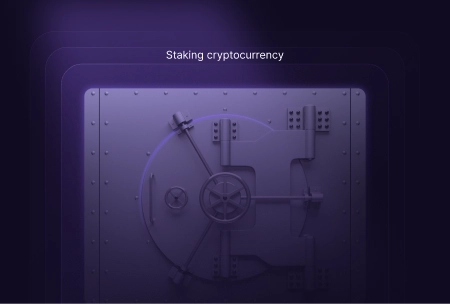What is staking and how does it work?


Have you ever heard of staking or Ethereum 2.0?
Ethereum 2.0 is based on measures implemented on the Ethereum network. The Ethereum network currently runs on a Proof of Work algorithm, which means that every node – computers involved in building the blockchain – validates every transaction.
As a result, the network can only validate approximately 15 transactions per second. This is a rather low number considering the number of Ethereum users. With Ethereum 2.0, the scalability of the system will be improved and should allow the validation of thousands of transactions per second.
Ethereum 2.0 works with staking. We prefer to reassure you, unlike mining, staking requires no technical knowledge to start. We will see that staking is a simple way to earn rewards by holding certain cryptocurrencies, such as Ether.
This article will allow you to understand what staking is, as well as how it works based on the case of Ethereum 2.0.
What is cryptocurrency staking?
Definition of staking
Staking uses a process adopted by Ethereum 2.0 that aims to immobilize ETH tokens in order to validate transactions, create blocks and secure the blockchain. Staking works with the help of a consensus called Proof of Stake, which we will define a little later in this article.
Transaction blocks are added to the Ethereum blockchain by validators who hold some stake in the native currency of this blockchain. The process is opposite to the mining process: Proof of Work.
Remember, we are talking about this process used to add blocks to the blockchain like Ether currently. But in the case of a Proof of Stake blockchain, the process is called forging – the opposite of mining and Proof of Work.
However, staking relies on a similar function to mining. These are two processes during which a network participant is selected to add the latest batch of transactions to the blockchain. With that, he earns cryptocurrencies in return.
If you own Ether, you have the opportunity to earn tokens in exchange for your stake. The specific amount depends on the amount of cryptocurrencies you stake.
By staking, we mean immobilizing cryptocurrencies on a network. For example, for the Ethereum 2.0 network, a 32 ETH validator generates approximately 4% per year for validating a block depending on the amount. The rewards also depend on the total amount of Ethereum invested on the network. It can range from 18% per year for less than 1 million stakes, to 1.81% for more than 100 million. You can also check out our Cruxpool validator to get an idea.
Just in case, if you missed our video on Ethereum 2.0 – or the end of the Proof of Work – here it is:
What is a Proof of Stake?
Proof of Stake is a consensus mechanism that increases the speed and efficiency of transactions while reducing costs. Proof of Stake reduces costs because it does not rely on solving mathematical problems like Proof of Work which requires a lot of energy to mine. With Proof of Stake, transactions are validated by stakers, that is to say individuals invested in the blockchain who practice staking.
This algorithm is faster, more secure and solves the problem of massive energy consumption that the Proof of Work system entails.
With Proof of Stake, there will no longer be machines investing their resources, but economic incentives. People who want to participate in the validation of transactions will be able to stake their Ethereum and become validators.
What are the pros and cons of staking cryptocurrencies?
Advantages of staking
There are several reasons to stake cryptocurrencies.
First of all, staking allows for a high potential return and requires less hardware than mining.
Furthermore, staking is a good way to put your assets to work by generating rewards instead of having idle crypto wallets.
Staking has the added benefit of contributing to the security and efficiency of blockchain projects By staking funds, we make the blockchain more resilient to attacks and strengthen its ability to process transactions.
Indeed, with Proof of Work, we think that without miners, there would be no blockchain. The number of participants in a blockchain guarantees the security and the proper functioning of a decentralized system. Staker is simpler than mining because there is no need to buy hardware. This makes it easier to adopt and more stable for the future.
Drawbacks of staking
However, staking is not a risk-free exercise.
The value of staked cryptocurrencies is not constant. In fact, the prices of cryptocurrencies are very volatile, which can make staking less profitable depending on the period.
In addition, in the case of Ethereum 2.0, we have to wait for withdrawals to be available to unlock our funds. But, once they are, outgoing transfers become possible.
Finally, it is important to keep in mind that staking is not entirely risk-free. Therefore, it is always important to use crypto wallets like MetaMask to store your crypto currencies.
How exactly does staking work? The case of Ethereum 2.0
The reason your cryptocurrency earns you rewards when staking is because the blockchain makes it work.
As we have seen, cryptocurrencies that rely on staking like Ether use Proof of Stake. This allows them to ensure that all transactions are verified and secure.
Staking your cryptocurrencies is necessary and makes it easier to manage a blockchain like Ethereum 2.0. It is a guarantee of legitimacy of any new transaction added to the blockchain. To validate a block, it is the duty of the staker to hold at least one token. We understand that, but how does it work in practice?
In the Proof of Stake system, validators process transactions and create new blocks on the blockchain – just as miners do in a Proof of Work blockchain. The difference is that, to earn the right to create a block, instead of making sure they are the first to solve complex mathematical problems like miners do, stakers (or nodes) do staking by immobilizing cryptocurrencies.
Then, a validator is chosen depending on the size and duration of the staking. This is how the most invested participants are rewarded. This validator forges the block and the other validators validate it. As a result, the validator receives a reward in the form of cryptocurrencies, such as Ether.
Sharding, beacon chain and epoch: What are we talking about?
If we go a little further into how Ethereum 2.0 improves its transaction management, we need to talk about sharding.
Sharding is a process that consists of dividing the work that needs to be done among several shards on the network. Initially, there will be 64 shards and each node will have to execute only one shard. With this system, nodes are easier to manage. In effect, nodes validate transactions in parallel instead of simultaneously. This means that more participants can join the network, making it more decentralized and secure.
You might be wondering how sharding is organized. Let’s talk about beacon chain. Beacon chain acts as a coordinator for the whole system, including the shards.
To explain how the shards work, we can talk about the period that sets the pace for the beacon chain: epoch. Epoch is the pillar of the blockchain that ensures the regular creation of blocks. An epoch is composed of 32 slots, each slot lasts 12 seconds.
At each epoch, validators are randomly assigned to committees, which are groups of at least 128 validators whose role is to validate the blocks suggested by the proposers. Randomness is crucial because it prevents a specific set of validators from coordinating fraudulent attacks.
Furthermore, the beacon chain is a very important part of the Ethereum 2.0 system because it organizes the work between shards. For now, the beacon chain is articulated with the transactions of the Ethereum 2.0 network and has no connection to the current Ethereum blockchain.
How is Proof of Stake secured compared to Proof of Work?
Ethereum 2.0 has a feature called slashing that punishes validators who engage in fraudulent activities. If the work is not done correctly or the staker is inactive, he will be punished.
Therefore, the system takes a portion of the Ethereum that the staker has put in based on the bad actions caused on the network. This ensures that everyone is doing their job properly and that no 51% attacks can occur.
Definition:
A 51% attack is an attack on a blockchain whereby one or more persons are able to control the majority of the hashrate, which can lead to network disruption.
Staking opens the door to the world of cryptocurrencies to anyone who would like to participate in the wonderful adventure of blockchains. Cryptocurrency staking is a simple and secure way to generate passive income. It is a good alternative to trading with which you can earn interest.
We hope you have understood what staking is and how it works. If you have any questions, feel free to join our Discord community!